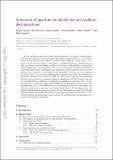Simulation of quantum circuits by low-rank stabilizer decompositions

View/
Date
2019-09-02Author
Bravyi, Sergey
Browne, Dan
Calpin, Padraic
Campbell, Earl
Gosset, David
Howard, Mark
Metadata
Show full item recordUsage
This item's downloads: 270 (view details)
Cited 23 times in Scopus (view citations)
Recommended Citation
Bravyi, Sergey, Browne, Dan, Calpin, Padraic, Campbell, Earl, Gosset, David, & Howard, Mark. (2019). Simulation of quantum circuits by low-rank stabilizer decompositions. Quantum, 3(181). doi: https://doi.org/10.22331/q-2019-09-02-181
Published Version
Abstract
Recent work has explored using the stabilizer formalism to classically simulate quantum circuits containing a few non-Clifford gates. The computational cost of such methods is directly related to the notion of
s
t
a
b
i
l
i
z
e
r
rank
, which for a pure state
ψ
is defined to be the smallest integer
χ
such that
ψ
is a superposition of
χ
stabilizer states. Here we develop a comprehensive mathematical theory of the stabilizer rank and the related approximate stabilizer rank. We also present a suite of classical simulation algorithms with broader applicability and significantly improved performance over the previous state-of-the-art. A new feature is the capability to simulate circuits composed of Clifford gates and arbitrary diagonal gates, extending the reach of a previous algorithm specialized to the Clifford+T gate set. We implemented the new simulation methods and used them to simulate quantum algorithms with 40-50 qubits and over 60 non-Clifford gates, without resorting to high-performance computers. We report a simulation of the Quantum Approximate Optimization Algorithm in which we process superpositions of
χ
∼
10
6
stabilizer states and sample from the full
n
-bit output distribution, improving on previous simulations which used
∼
10
3
stabilizer states and sampled only from single-qubit marginals. We also simulated instances of the Hidden Shift algorithm with circuits including up to 64
T
gates or 16 CCZ gates; these simulations showcase the performance gains available by optimizing the decomposition of a circuit's non-Clifford components.

